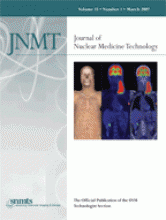
D. SCOTT HOLBROOK, CNMT, PET, FSNMTS
Since the introduction of the first clinical PET/CT, the medical imaging community has been playing catch up to provide well-trained professionals to operate the device. Due to significant obstacles in the educational and regulatory arenas, the transition to multimodality imaging has been difficult. Fortunately, for those currently practicing in the field—and for future generations of imaging specialists—professional medical societies have been working diligently together to break down barriers and allow career pathways that will lead to multicredentialed technologists.
Initially, the debate in the field was “Who is most qualified to operate PET/CT scanners?” A PET/CT consensus conference was organized in July 2002 that included representatives from numerous stakeholder organizations. The group agreed that ideally those who operate PET/CT devices would be dually credentialed in nuclear medicine and CT. However, at that time fewer than 5,000 imaging professionals possessed both the ARRT radiography credential and a nuclear medicine credential from NMTCB or ARRT, and fewer than 200 imagers possessed both a CT and nuclear medicine credential. Because so few practicing technologists possessed these credentials, the conference participants realized that it would have been unreasonable to recommend that operators of PET/CT devices possess dual credentials in 2002. This would have likely hindered growth of the modality and limited access to the technology. Instead, they recommended that multiple pathways be created to educate or train registered nuclear medicine technologists, radiographers, and radiation therapists to operate PET/CT equipment.Consensus Statement No. 1—Personnel Qualified To Operate PET/CT Equipment: Any registered radiographer with the credential RT(R), registered radiation therapist with the credential RT(T), or registered nuclear medicine technologist with the credentials RT(N) or CNMT may operate PET/CT equipment after obtaining appropriate additional education or training and demonstrating competency. It is acknowledged that some individuals will require more extensive additional education and training than others. A task force appointed by the American Society of Radiologic Technologists and the Society of Nuclear Medicine Technologist Section will determine appropriate levels of education or training. The task force will use the results of a task analysis to identify core competencies for operators of PET/CT equipment, review and evaluate existing operator training materials, outline a formal course of study for PET/CT technologists, and recommend appropriate methods for delivering the educational content.
Following the recommendations of this meeting, NMTCB developed the PET certification exam to allow nuclear medicine technologists—and those with radiology backgrounds working in PET—the opportunity to achieve special distinction for expertise and experience in PET. Additionally, ARRT created a pathway for nuclear medicine technologists to earn the CT credential. After the development of credentials for those who possess knowledge in PET/CT, it is now necessary to focus on state regulations that will permit those who have the appropriate backgrounds to practice their skills. This has been a difficult task. Each state determines which individuals are appropriately credentialed to practice in a given imaging facility. It is for this reason that there is variability from state to state as to who is qualified to perform PET/CT exams. In order to address this phenomenon, each state's regulations must be addressed independently.Consensus Statement No. 2—Regulation of Personnel Who Operate PET/CT Equipment: States that license radiographers, nuclear medicine technologists, or radiation therapists are encouraged to amend their regulations to permit any of these individuals to perform PET/CT examinations after they have received appropriate additional education or training and demonstrated competency. States that do not currently license radiographers, nuclear medicine technologists, or radiation therapists are encouraged to adopt laws that regulate the education and credentialing of these individuals. The Consumer Assurance of Radiologic Excellence bill, a federal legislative proposal, may be used as a model for state statutes governing the regulation of personnel who plan and deliver radiation therapy and perform any diagnostic imaging examinations except medical ultrasound.
SNMTS encourages its members to actively participate in lobbying at the state level for appropriate legislation for PET/CT and multimodality imaging. While SNMTS can provide resources and assistance, state-level issues require the action of constituents of a given state. At the national level, SNMTS leadership continues to join other stakeholders in lobbying for national licensure legislation.







